British Voters Head To The Polls In The Wake Of Campaign Marred By Terror Attacks
Great Britain heads to the polls today.
When British Prime Minister Theresa May called a snap election back in mid-April, it looked as though the main issues in race would revolve around the country’s exit from the European Union pursuant to the results of last year’s referendum and the question of whether or not voters would give May and her Conservative Party the support in Parliament that she needed for the “hard” Brexit approach she had chosen to adopt. Since then, though, the attention of Britons has been diverted by other concerns thanks to a twin terror attacks barely a month apart in Manchester and Central London that together result in more than thirty deaths and more than one hundred people injured. Additionally, the polling at the beginning of the race appeared to show the Conservatives headed for a major victory bigger than what we saw in either 2010 or 2015 that would give May a mandate that would last until 2022 when new elections would be required to take place. Instead, we’ve seen Labour close the gap between the two parties over the past month of campaigning, making it unclear what the House of Commons will look like when the country wakes up tomorrow morning. To be sure, there has been discussion and argument over Brexit during the campaign, as well as other issues that traditionally dominate British elections such as the economy and the National Health Service. Additionally, while the polls have closed to some degree, Conservatives continue to hold a solid lead over Labour and it seems unlikely that the Tories will actually lose control of Parliament. As The Washington Post puts it, though, this has not been the campaign that many expected:
LONDON — Britain’s suddenly unpredictable election campaign moved to the ballot box Thursday as voting began in a race that Prime Minister Theresa May once had solidly in her grip but then reshaped by terrorists attacks in London and Manchester.
May called the snap election seeking to increase her political power ahead of Britain’s exit negotiations with the European Union, pitching herself as the best leader to enter into complex divorce talks.
But the contest shifted in ways no one could have predicted. In a matter of weeks, her far-left opponent, Jeremy Corbyn, has surged as security issues overshadowed the Brexit talks.
As the campaign wrapped up, May’s seemingly insurmountable lead had dwindled to — in at least some polls — to a few points.
May was still expected to pull it out. But if the Labour Party takes control of parliament — and hands Corbyn the keys to 10 Downing Street — it would rival, and perhaps top, 2016’s Brexit vote or President Trump’s November victory for most implausible political outcome of the past 12 months.
May’s pitch won over Miranda John, a 52-year-old mortgage broker who lives in south London and was one of the first to vote after polls opened at 7 a.m. John said she voted for May’s Conservative Party “because of fears of Brexit” and her belief that the Conservatives have “a better negotiation team.”
“I was a Remainer,” she said, referring to the E.U. referendum held last June. “But I accept that the will is to leave so we need to get the right deal.”
But concerns over how to handle the Brexit talks have been increasingly overshadowed by security worries following two attacks in a span of less than two weeks.
On May 22, a suicide bomber killed 22 people at the conclusion of an Ariana Grande concert in Manchester. In London, eight people died following a van-and-knife rampage around the bustling London Bridge area last Saturday.
May denounced the “tolerance of extremism” that she said persisted in some quarters in Britain — remarks that amounted to an implicit rebuke of Corbyn, who has in the past expressed sympathy for Hamas, Hezbollah and the Irish Republican Army.
But Corbyn quickly pivoted the debate to police cuts that May had authorized during her six-year tenure as home secretary, the nation’s top domestic security official.
The prime minister, he said, had tried to protect Britain “on the cheap” — a message that fit with his anti-austerity mantra and that resonated as details emerged of security services’ failures to thwart the plots.
Even a win for May, if it’s insufficiently convincing, could leave her seriously damaged within her own party and hobbled going into all-important negotiations with European leaders that will determine whether the country’s European Union exit is the success she has promised or a grievous mistake.
“She’ll still win the election, but she’ll be weaker for it,” said Steven Fielding, a political-science professor at the University of Nottingham. “Jeremy Corbyn will lose the election, but he’ll be stronger for it.”
The irony of that outcome, if it comes to pass, will be heightened by the fact that May didn’t need to hold the vote in the first place. With another election not due until 2020, May had repeatedly vowed to wait until then to face the voters after coming to power last year via a selection by her fellow Tory lawmakers.
But the temptation of her party’s more than 20-point lead over Corbyn’s Labour Party proved too great, and the normally cautious May gambled in April by calling an early vote.
At the time, the decision was hailed by observers as a masterstroke — one that could grow her slender parliamentary edge into a historically large majority, giving her the sort of one-woman authority that even Thatcher would have envied.
May would need that sort of endorsement, she insisted in her pitch to voters, so she could stand up to her European counterparts with the knowledge that the country was behind her. Only a strong majority, she argued, would give her leverage to drive the best possible bargain for Britain in the contentious talks to come.
Polls showing that voters admired her resolute and no-nonsense persona — she vowed to be a “bloody difficult woman” in the E.U. talks — suggested she would get what she sought.
But as the campaign has worn on, voters appear to be less convinced that they want to hand her such sweeping control.
“Up until the campaign, events had played to her strengths,” said Rosa Prince, author of a biography of May. “But she does have her frailties. And campaigning seems to have brought a lot of those out.”
Among them: a need to micromanage, an inability to be spontaneous and a distinct absence of the common touch. Her campaign has been widely criticized for being stilted and soulless, with May ducking debates and rarely venturing beyond the friendly confines of scripted events with hand-picked Conservative activists.
As I noted above, while the polling gap has closed from the wide gap we saw in the immediate aftermath of the calling of the election, the Tories remain in the lead. You can track the course of that polling via the poll trackers from the BBC, The Economist, The Guardian, and The Telegraph. It’s worth noting, though, that the previous two national elections have both been marked by polling that didn’t quite catch the national trend. In the 2015 General Election, for example, the final pre-election polls showed a close race between David Cameron’s Conservatives and a Labour Party that was then being headed up by Ed Milliband. When the dust finally settled on the morning after voting that year, though, the Tories had managed to win a significant victory while Labour suffered a significant defeat, including devastating losses in Scotland where nearly the entire Labour slate saw its seats snapped up by Nicola Sturgeon’s Scottish National Party. That election also proved to be a significant setback for the Liberal Democrats, who lost nearly all of their seats in the House of Commons, and the upstarted UK Independence Party, which has been in many ways the driving force behind the movement that ultimately came to a head with last year’s Brexit vote. In that vote, the final polls before the referendum indicated that ‘Remain’ was in the lead. In the end, of course, the ‘Leave’ forces proved to be stronger at the polls and that set in motion the chain of events that have led to today.
Finally, it’s worth noting that, much like the Generic Congressional Ballot here in the United States and the race for control of the House of Representatives, today’s vote is in some sense a separate election in each of the 650 constituencies that make up the House of Commons. This means that national polling doesn’t necessarily tell us anything helpful about the individual races that will decide who will control Parliament or how big their majority will be. This, of course, is because the nation as a whole has a significantly different demographic and ideological makeup than individual districts (or constituencies) may have. Just as there are seats that are solidly Democratic or Republican here in the states that will remain so regardless of how the national popular vote goes, there are solidly Labour and Conservative seats in the United Kingdom that are unlikely to change hands absent some kind of wave election that seems unlikely this year. Added to the complexity of trying to figure out how things will play out at the constituency level are the existence of third, fourth, and fifth (or more) parties in many parts of Great Britain that could end up having a major impact in deciding who wins an individual seat, and more broadly how that impacts the battle for control of Parliament. The best example of that, of course, came in 2015 in Scotland, which had been a Labour stronghold for decades. That advantage in Scotland was helpful to Labour in the past in maintaining strong numbers in Parliament even while the Tories increased their level of support in England and elsewhere in the U.K. The rise of the SNP, though, has slowly but surely chipped away at that Scottish firewall, and it proved devastating to Labour two years ago when its representation in Scotland was utterly devasted.
Nate Silver and Harry Enten preview the election at FiveThirtyEight, and note that there are three scenarios for how things turn out today. Either we see a narrow Conservative win, a huge Conservative landslide, or the Conservatives somehow lose control of the House of Commons. Of these three, it seems clear to me that a Labour victory or a scenario that allows Labour to take control via a power-sharing arrangement with a third or fourth party is the least likely of the outcomes. While the Tories have slipped in the polls, they still remain on top and if that is reflected at the constituency level then Tory candidates will be in good shape. Based on polling during this election cycle, it doesn’t appear that a comeback for Labour in Scotland is likely, and that makes any chance they might have of regaining control of the House of Commons less and less likely. Additionally, it seems likely from the polling that Liberal Democrats will regain at least some of their former support today, and that is likely to hurt Labour from regaining seats it lost in the heart of England if Lib Dem candidate ends up dividing up the field sufficiently to allow Conservative Party candidates to win.
Looking at the matter realistically, then, it seems clear that the Conservative Party will hold on to power in Parliament, the only real question is what happens to their majority. The first possibility is that they lose seats. What impact that may have will depend largely on how many seats are lost. If it’s only a handful then May will be in good, albeit weakened, shape. If it’s a large number of seats and the Tories end up with a much slimmer majority, then that will have a big impact going forward both on how Parliament operates and on the Brexit negotiations. If the Tories add to their majority, though, then May’s decision to call a snap election will be vindicated and her hand in negotiating with the European Union will be significantly strengthened.
For those of you interested in today’s outcome, The New York Times has a good article telling us what to watch for as the results roll in later today, as does Politico, and Buzzfeed’s United Kingdom wing has a good timeline of when results can be expected and what constituencies could give us an early indication of which way the election may go. The first indications of where the election may be headed will likely come sometime after 5 pm on the East Coast of the United States when the national exit poll will be released. While not a final result, that poll has been fairly close to final results in recent elections, especially two years ago when it was the first indication of the big Tory win that we ultimately saw. Additionally, there will likely be live coverage of the result on BBC News for those of you in the United States who get that in your cable package, It’s also likely that C-Span will simulcast election coverage from ITV News on one of its channels as it has in the past. Finally, for those of you on Twitter, I have created a Twitter List of British news outlets, pundits, and election-related Twitter accounts that will be posting results throughout the night.
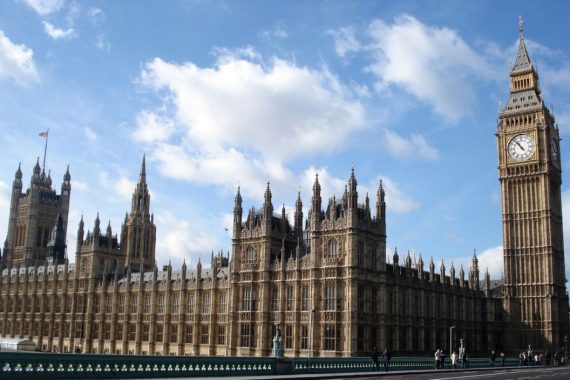

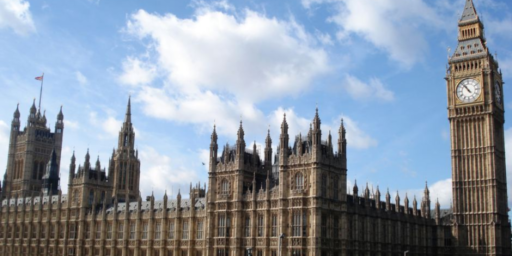
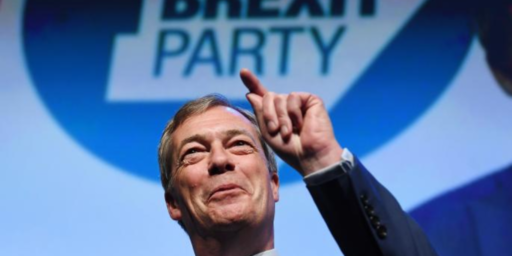
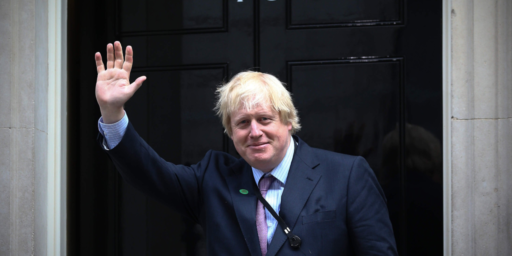
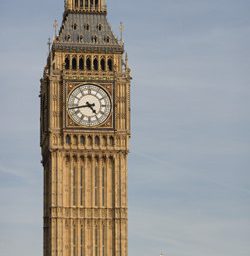
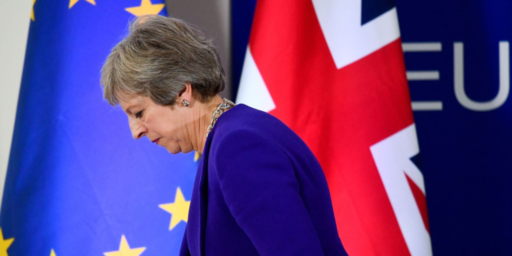
Looks like Theresa May may have screwed herself. The exit polls point to her losing her majority but staying in power. Her play had been to build an overwhelming number of seats, supposedly so she could bargain from a position of strength on Brexit.
Guess again.
@michael reynolds:
We’ll see. That Exit Poll was spot on in 2015, but has been wildly inaccurate in the past.
Exit poll pointing to hung parliament.
Whoops!